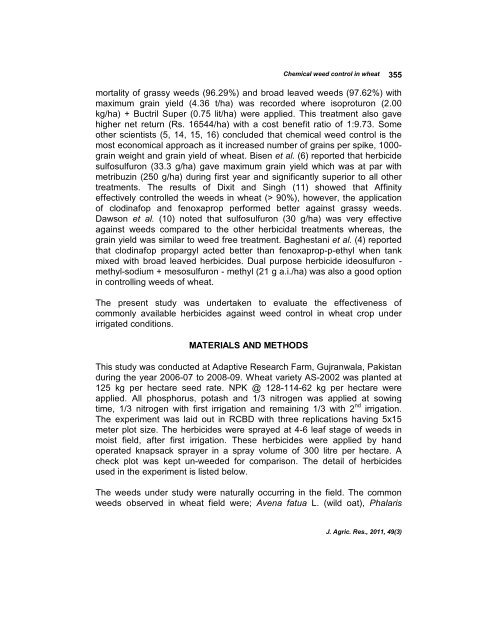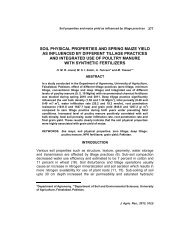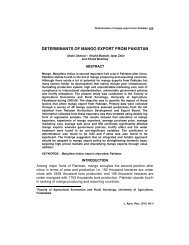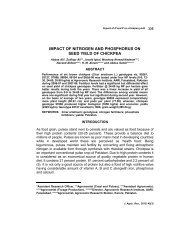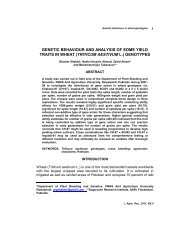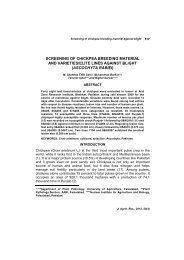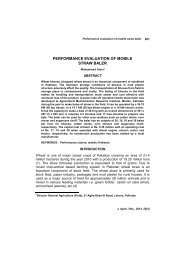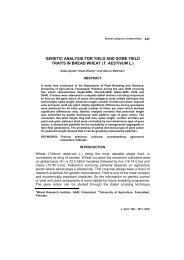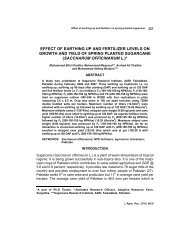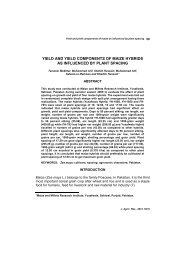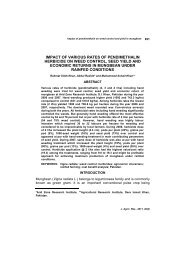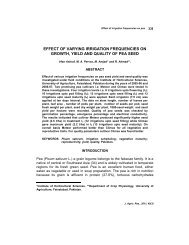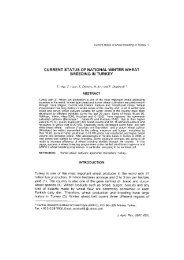chemical weed control in wheat under irrigated conditions
chemical weed control in wheat under irrigated conditions
chemical weed control in wheat under irrigated conditions
Create successful ePaper yourself
Turn your PDF publications into a flip-book with our unique Google optimized e-Paper software.
Chemical <strong>weed</strong> <strong>control</strong> <strong>in</strong> <strong>wheat</strong>355mortality of grassy <strong>weed</strong>s (96.29%) and broad leaved <strong>weed</strong>s (97.62%) withmaximum gra<strong>in</strong> yield (4.36 t/ha) was recorded where isoproturon (2.00kg/ha) + Buctril Super (0.75 lit/ha) were applied. This treatment also gavehigher net return (Rs. 16544/ha) with a cost benefit ratio of 1:9.73. Someother scientists (5, 14, 15, 16) concluded that <strong>chemical</strong> <strong>weed</strong> <strong>control</strong> is themost economical approach as it <strong>in</strong>creased number of gra<strong>in</strong>s per spike, 1000-gra<strong>in</strong> weight and gra<strong>in</strong> yield of <strong>wheat</strong>. Bisen et al. (6) reported that herbicidesulfosulfuron (33.3 g/ha) gave maximum gra<strong>in</strong> yield which was at par withmetribuz<strong>in</strong> (250 g/ha) dur<strong>in</strong>g first year and significantly superior to all othertreatments. The results of Dixit and S<strong>in</strong>gh (11) showed that Aff<strong>in</strong>ityeffectively <strong>control</strong>led the <strong>weed</strong>s <strong>in</strong> <strong>wheat</strong> (> 90%), however, the applicationof clod<strong>in</strong>afop and fenoxaprop performed better aga<strong>in</strong>st grassy <strong>weed</strong>s.Dawson et al. (10) noted that sulfosulfuron (30 g/ha) was very effectiveaga<strong>in</strong>st <strong>weed</strong>s compared to the other herbicidal treatments whereas, thegra<strong>in</strong> yield was similar to <strong>weed</strong> free treatment. Baghestani et al. (4) reportedthat clod<strong>in</strong>afop propargyl acted better than fenoxaprop-p-ethyl when tankmixed with broad leaved herbicides. Dual purpose herbicide ideosulfuron -methyl-sodium + mesosulfuron - methyl (21 g a.i./ha) was also a good option<strong>in</strong> <strong>control</strong>l<strong>in</strong>g <strong>weed</strong>s of <strong>wheat</strong>.The present study was <strong>under</strong>taken to evaluate the effectiveness ofcommonly available herbicides aga<strong>in</strong>st <strong>weed</strong> <strong>control</strong> <strong>in</strong> <strong>wheat</strong> crop <strong>under</strong><strong>irrigated</strong> <strong>conditions</strong>.MATERIALS AND METHODSThis study was conducted at Adaptive Research Farm, Gujranwala, Pakistandur<strong>in</strong>g the year 2006-07 to 2008-09. Wheat variety AS-2002 was planted at125 kg per hectare seed rate. NPK @ 128-114-62 kg per hectare wereapplied. All phosphorus, potash and 1/3 nitrogen was applied at sow<strong>in</strong>gtime, 1/3 nitrogen with first irrigation and rema<strong>in</strong><strong>in</strong>g 1/3 with 2 nd irrigation.The experiment was laid out <strong>in</strong> RCBD with three replications hav<strong>in</strong>g 5x15meter plot size. The herbicides were sprayed at 4-6 leaf stage of <strong>weed</strong>s <strong>in</strong>moist field, after first irrigation. These herbicides were applied by handoperated knapsack sprayer <strong>in</strong> a spray volume of 300 litre per hectare. Acheck plot was kept un-<strong>weed</strong>ed for comparison. The detail of herbicidesused <strong>in</strong> the experiment is listed below.The <strong>weed</strong>s <strong>under</strong> study were naturally occurr<strong>in</strong>g <strong>in</strong> the field. The common<strong>weed</strong>s observed <strong>in</strong> <strong>wheat</strong> field were; Avena fatua L. (wild oat), PhalarisJ. Agric. Res., 2011, 49(3)


